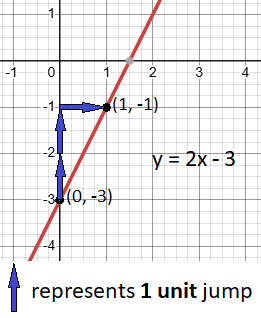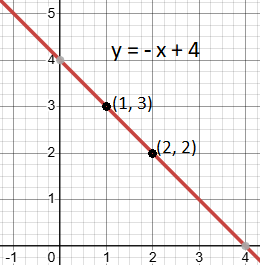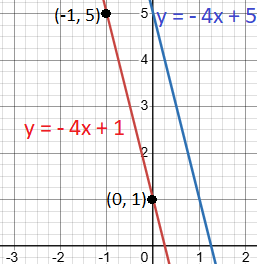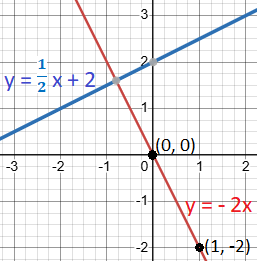In this guide, we’ll explore how to calculate the slope-intercept form of a line and graph it in different scenarios. The slope-intercept form is one of the most useful ways to write the equation of a line, as it shows the line’s steepness and where it crosses the y-axis. Whether you’re given a slope and y-intercept of a line, two points on the line, a point on a line and parallel to another line or a point on a line and perpendicular to another line, this tutorial will make each step clear with examples and graphs.
By the end, you’ll understand how to calculate the slope-intercept form and use it to easily plot lines on a graph. Let’s get started!
What is the Slope-Intercept Form?
The slope-intercept form of a line is a way to write the equation of a line so that you can easily see the slope and y-intercept:
y = mx + b
- m represents the slope (how steep the line is).
- b is the y-intercept (the point where the line crosses the y-axis).
(For more information, see my post: Slope-Intercept Form of a Linear Equation: A Simple Guide.)
How to Calculate Slope-Intercept Form: Examples and Graphing Steps
Let’s go through four examples to understand how to calculate and graph the slope-intercept form of a line in different cases.
Example 1: Given Slope and Y-Intercept
Problem:
If the slope m = 2 and y-intercept b = −3, find the slope-intercept form of the line and graph it.
Solution:
- Insert the values of the slope m and y-intercept b into the equation y = mx + b:
- y = 2x − 3
- Graphing Steps:
- Start by plotting the y-intercept point. The y-intercept b being − 3 indicates that it is located at the point (0, − 3).
- Now, let’s find a second point on the line. The slope of equation y = 2x − 3 is 2:
- Since slope is positive, from point (0, – 3), move up 2 units and then right 1 unit to plot the point (1, – 1) on the graph.
- Draw a line passing through points (0, -3) and (1, – 1) to represent the equation y = 2x − 3.
For a detailed explanation of how to graph the slope-intercept form, including tips and examples, check out How to Graph Slope-Intercept Form.

Now, you have graphed the line with a slope of 2 and y-intercept at – 3
Example 2: Given Two Points on the Line
Problem:
Find the equation of a line passing through the points (2, 2) and (1, 3)
Solution:
Formula for Slope
Let ![]() and
and ![]() are two distinct points on a non-vertical line. The slope m is given by:
are two distinct points on a non-vertical line. The slope m is given by:
Slope = m = ![]()
(If you need a review, check out my post: How to Calculate the Slope of a Line)
- Calculate the slope m:
- Slope m =
 ⇒
⇒  = – 1
= – 1
- Slope m =
- Substitute into the slope-intercept form:
- y = – x + b
- Find b:
- Using point (2, 2), put x = 2 and y = 2 in equation y = – x + b:
- 2 = – 2 + b
- Add 2 on both sides
- b = 4
- Using point (2, 2), put x = 2 and y = 2 in equation y = – x + b:
- So, the equation of a line passing through the points (2, 2) and (1, 3) is:
- y = – x + 4
- Graphing Steps:
- Start by plotting the points (2, 2) and (1, 3).
- Draw the line through these points.

Example 3: Given a Point and a Line Parallel to Another Line
Problem:
Find the equation of a line that passes through (-1, 5) and is parallel to the line y = – 4x + 5.
Solution:
Rule for Identifying Parallel Lines:
Let L1 and L2 are two non-vertical lines with slopes m1 and m2 respectively. Then the lines L1 and L2 are parallel if and only if they have the same slope. That is,
m1 = m2
(If you need a review, check out my post: How to Identify Parallel and Perpendicular Lines Using Slopes)
- Since the new line is parallel to the line y = – 4x + 5, so it has the same slope as y = – 4x + 5.
- Slope of the line y = – 4x + 5 is – 4, so slope m of the new line is also – 4.
- Substitute the slope m into the equation y = mx + b:
- y = − 4x + b
- Find b:
- (-1, 5) is a point on a new line. Substitute (x, y) = (-1, 5) in y = – 4x + b:
- y = – 4x + b.
- 5 = − 4(– 1) + b
- 5 = 4 + b
- Subtract 4 on both sides
- 4 + b – 4 = 5 – 4
- b = 1
- (-1, 5) is a point on a new line. Substitute (x, y) = (-1, 5) in y = – 4x + b:
- The equation of a line that passes through (-1, 5) and is parallel to the line y = – 4x + 5 is:
- y = − 4x + 1
- Graphing Steps:
- Plot the given point (-1, 5)
- The y-intercept being 1 indicates that it is located at the point (0, 1).
- Draw a line through these two points.

Example 4: Given a Point and a Line Perpendicular to Another Line
Problem:
Find the equation of a line passing through (1, − 2) and perpendicular to the line y = ![]() x + 2.
x + 2.
Solution:
Rule for Identifying Perpendicular Lines:
Let L1 and L2 are two non-vertical lines with slopes m1 and m2 respectively. Then the lines L1 and L2 are perpendicular to each other if and only if the product of their slopes is -1. That is,
m1 m2 = -1
(If you need a review, check out my post: How to Identify Parallel and Perpendicular Lines Using Slopes)
- Find the perpendicular slope. Slope of line y =
 x + 2 is
x + 2 is  . Slope m of a line perpendicular to it would be − 2.
. Slope m of a line perpendicular to it would be − 2. - Substitute into the slope-intercept form y = mx + b:
- y = − 2x + b
- Find b:
- Substitute (x, y) = (1, − 2) in y = − 2x + b:
- − 2 = − 2 (1) + b
- – 2 = – 2 + b
- b = 0
- Substitute (x, y) = (1, − 2) in y = − 2x + b:
- The equation of a line passing through (1, − 2) and perpendicular to the line y =
 x + 2 is:
x + 2 is:- y = − 2x
- Graphing Steps:
- Plot the given point (1, – 2)
- The y-intercept being 0 indicates that it is located at the point (0, 0).
- Draw a line through these points.

Conclusion
Calculating the slope-intercept form of a line can be done with just a few easy steps, depending on the information you’re given. By following the examples above, you can now confidently determine the slope-intercept form and graph it, whether you know the slope and intercept, need to work from two points or have a point on a line that is parallel or perpendicular to another line.
These examples give you the skills to solve and graph linear equations across different scenarios.
Related Posts:
- Introduction. Linear Equation of a line parallel to y-axis
- Linear Equation and graph of a line parallel to x-axis
- What is the Slope of a Line
- How to Calculate the Slope of a Line
- Solved example of finding slope of a line that passes through two given points
- How to Identify Parallel and Perpendicular Lines Using Slopes
- How to derive Linear Equation using Point-Slope Form
- How to easily find X-Intercept and Y-Intercept of a Linear Equation
- Slope-Intercept Form of a Linear equation. A Simple Guide